lunch Foods that warm for cold days
Winter brings chilly temperatures that make us crave warm, comforting meals. When it comes to lunch, opting for foods that provide a cozy and satisfying experience becomes essential. Let’s dive into the world of lunch foods that warm the soul on those cold, wintry days.
Introduction
As the winter months settle in, the desire for warm and hearty meals intensifies. The importance of choosing lunch options that not only satisfy our taste buds but also provide a sense of comfort cannot be overstated. In this article, we’ll explore the benefits of incorporating warm lunch foods into our winter routines and discover a variety of delicious options to keep us cozy throughout the season.
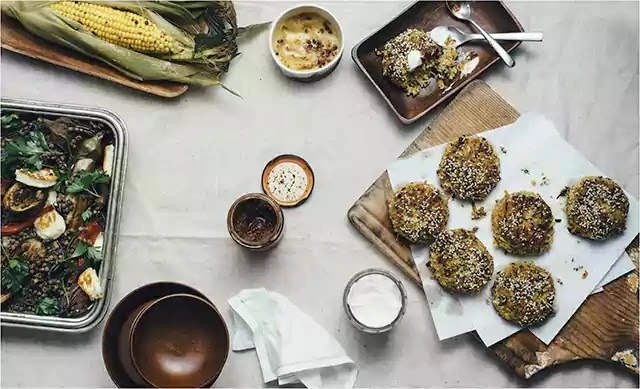
Warm haloumi, lentil and eggplant salad
Haloumi is heating, so use it in moderation, especially if you are a fiery, competitive Pitta type who, like me, is attracted to those salty, more intensely flavoured cheeses.

I need to talk about cooking eggplant here. If you are frying eggplant, you need to use quite a bit of oil. The eggplant absorbs the oil, but as it cools, it releases the oil, so make sure you drain it on paper towel before serving it.
- 210 g (1 cup) puy lentils
- 3 tablespoons olive oil
- 4 small eggplants, halved
- 1 red capsicum, cut into thick strips
- 2 red onions, cut into wedges
- 400 g haloumi, thickly sliced
- a handful of flat-leaf parsley leaves, chopped
Dressing
- 1 tablespoon dijon mustard
- 1 garlic clove, crushed
- 1 tablespoon orange juice
- 2 tablespoons olive oil
Preheat the oven to 200°C. Line a baking tray with baking paper.
Put the lentils into a saucepan, cover with water and cook over medium heat for 20 minutes, until just soft. Be careful not to overcook them or they will break up when you mix the salad. Drain and set aside.
Heat the oil in a large frying pan, add the eggplant, in batches, and cook over medium heat until golden brown. Transfer the eggplant to the prepared tray, add the capsicum and onion and bake for 30 minutes, until the vegetables are tender.
Cook the haloumi, without oil, in a non-stick frying pan over medium heat until golden brown on both sides.
Put the lentils, vegetables, parsley and haloumi into a bowl.
To make the dressing, whisk together the mustard, garlic, orange juice and olive oil.
Pour the dressing over the salad and gently mix to combine.
Serves 4–6
Millet and vegetable patties with harissa yoghurt
In case you haven’t noticed, I have a bit of a thing for millet. I like that it can be cooked in a rice cooker, it tastes and looks similar to couscous and at the time of writing this book is about one-quarter of the price of quinoa. It is a good source of magnesium and fibre and was the staple grain in Europe before potatoes and corn were introduced. Millet takes about 25 minutes to cook and requires double the amount of liquid to the grain.
- 210 g (1 cup) millet, rinsed
- 400 g can chickpeas, rinsed and drained
- a handful of flat-leaf parsley leaves, coarsely chopped
- 1 tablespoon hulled tahini
- 2 teaspoons curry powder
- 1 free-range egg, lightly whisked
- 1 small onion, grated
- 1 carrot, grated
- 1 zucchini, grated
- 125 g (1 cup) grated pumpkin
- 1 tablespoon black chia seeds
- 2 tablespoons sesame seeds
- 130 g (½ cup) Greek-style yoghurt
- ½ teaspoon harissa
- Pickled vegetables, to serve
Preheat the oven to 200°C. Line a baking tray with baking paper.
Put the millet into a saucepan, cover with 500 ml (2 cups) of water and bring to the boil. Reduce the heat to low, cover with a lid and cook for 25 minutes, until the millet is tender and the liquid has been absorbed. Alternatively, put the millet into a rice cooker with 500 ml (2 cups) of water and cook until soft.
Combine the chickpeas, parsley, tahini and curry powder in a food processor, process until smooth. Transfer to a bowl and fold in the millet, egg and vegetables. Using wet hands, shape the mixture into patties, then press into the combined chia and sesame seeds.
Place on the prepared tray and bake for 30 minutes, until crisp and golden.
Put the yoghurt and harissa in a bowl and gently fold together.
Serve the patties with the harissa yoghurt and the pickled vegetables.
Serves 4

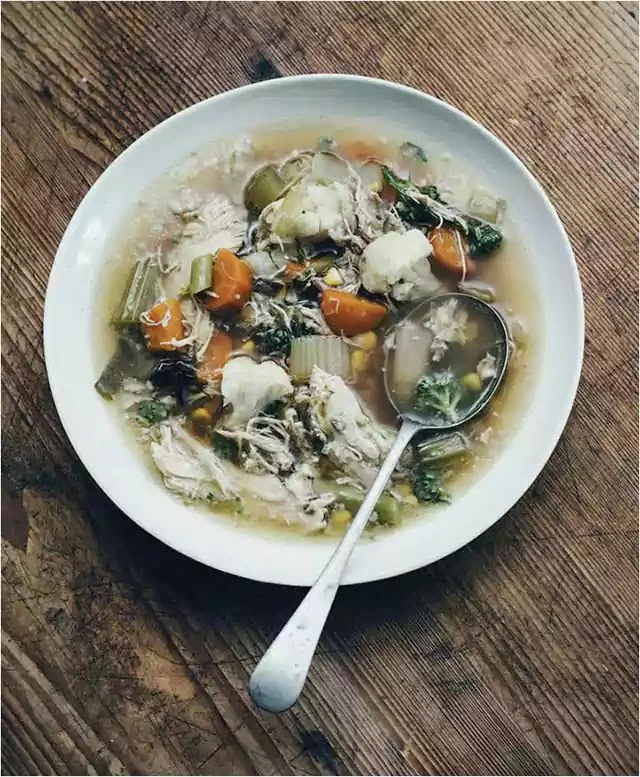
Nourishing chicken soup
This is the favourite recipe ever of my friend Kelly, who is also the wonderful designer of this book. I first made it for her a couple of years ago when she was poorly. She hasn’t stopped mentioning it since. You should have seen her joy when I sent her home with the whole pot after we photographed it for these pages.
Simmer your soup until the meat falls away from the bones, topping up the water as needed. I never bother removing all the bones, just the big ones my tongs can find. I like to chew on the smaller ones because the marrow inside them is also very healing.
- 1 × 1.6 kg free-range chicken
- 1 cinnamon stick
- 3 star anise
- 4 whole cloves
- 6 black peppercorns
- 2 tablespoons coriander roots
- 6 spring onions
- 1 garlic bulb, halved
- 5 cm piece of fresh ginger, sliced
- 3 celery stalks, chopped
- 3 carrots, chopped
- 250 ml (1 cup) shaoxing rice wine (optional)
- 1 tablespoon tamari
- 300 g cauliflower, cut into florets
- 2 cobs corn, kernels removed
- 300 g broccoli, cut into florets
Put the chicken into a very large saucepan or stockpot, add the spices, spring onion, garlic, ginger, celery, carrot, shaoxing rice wine and 4 litres (16 cups) of water and cook over medium heat for 3 hours, until the chicken is very soft and falling away from the bones. You may need to add more water during this time to keep the chicken covered. Remove any large bones and discard.
Add the tamari, cauliflower and corn kernels to the soup and cook for 15 minutes, until the cauliflower is soft. Add the broccoli and cook for 5 minutes, until soft.
Serves 6–8
I wholeheartedly believe that chicken soup is medicine. There is magic in this broth; it nourishes as no other food can, calms the body and soothes the worried mind.
Corn with salt and pepper seeds
I find corn is very filling and often have it for lunch or dinner. And I try to have seeds with most of my meals – they are a simple way of adding protein, which helps fill me up, and are packed with goodness.
- 4 corn cobs
- ½ teaspoon white peppercorns
- 1 teaspoon pink peppercorns
- ½ teaspoon pink sea salt
- 2 tablespoons sunflower seeds
- 3 tablespoons ghee
Put the corn cobs into a large saucepan of water and cook over high heat for 15 minutes, until the corn is tender. Drain well.
Meanwhile, toast the white and pink peppercorns in a frying pan over medium heat for 3 minutes, until fragrant. Add the salt and seeds and cook, giving the pan a shake occasionally, for another 3 minutes. Transfer the mixture to a mortar and pestle and pound to form a coarse salt.
Brush the corn cobs with the ghee and sprinkle with the salt and pepper seeds.
Serves 4
Pickled vegetables
If you haven’t already heard, fermented foods are the new thing – but there is nothing new about them. Just about every culture has eaten fermented foods since the beginning of time. It is not just a great way of preserving food, it also helps us maintain the healthy bacteria in our gut.
- 75 g (1 cup) shredded Chinese cabbage (wong bok)
- 1 Lebanese cucumber, thinly sliced
- 1 teaspoon coriander seeds
- 1 teaspoon fennels seeds
- 1 teaspoon black peppercorns
- 1 small red chilli
- 1 carrot, thinly sliced
- 50 g sunflower sprouts
- 1 small daikon radish or 6 red radishes, thinly sliced
- 1 small red onion, thinly sliced
- 1 tablespoon sliced fresh ginger
- 1 cinnamon stick
- 250 ml (1 cup) rice wine vinegar
- 2 teaspoons coconut sugar
- 2 teaspoons sea salt
Preheat the oven to 100°C. Wash a 500 ml (2 cup) glass preserving jar in hot, soapy water, then rinse. Place the jar upside down on a baking tray and transfer to the oven to dry. After 10 minutes, invert and continue to heat until the jar is completely dry.
Layer the vegetables and spices in your sterilised jar.
Whisk the vinegar, 125 ml (½ cup) of water, the sugar and salt in a bowl until the sugar dissolves. Pour over the vegetables.
Seal the jar and allow to stand overnight or longer if you want them to be more pickled. The longer they are left, the tastier they will be. I usually leave them for a week or two before I use them.
Makes 520 g (2 cups)
Speckled quinoa sushi
- 100 g (½ cup) tricoloured quinoa, rinsed
- 2 teaspoons seasoned rice vinegar
- 4 nori sheets
- 150 g smoked tofu
- 1 red capsicum, thinly sliced
- 1 small Lebanese cucumber, cut into thin strips
- 1 tablespoon undyed pickled ginger
- tamari, to serve
- wasabi, to serve
Put the quinoa in a saucepan of water and bring to the boil over high heat. Reduce the heat and simmer for 15 minutes, until tails appear and separate from the grain. Rinse under cold water and drain well to remove any excess moisture. Stir in the rice vinegar and allow to cool completely.
Lay a sheet of nori on a bamboo sushi mat, place 2 tablespoons of cooked quinoa at one end, flatten slightly, then top with some tofu, capsicum, cucumber and pickled ginger, allowing a little capsicum, cucumber and tofu to overhang the top edge of the nori. Roll up into a cone and seal the end with a few grains of quinoa. Repeat with the remaining nori sheets. Serve with small bowls of the tamari and wasabi.
Serves 4
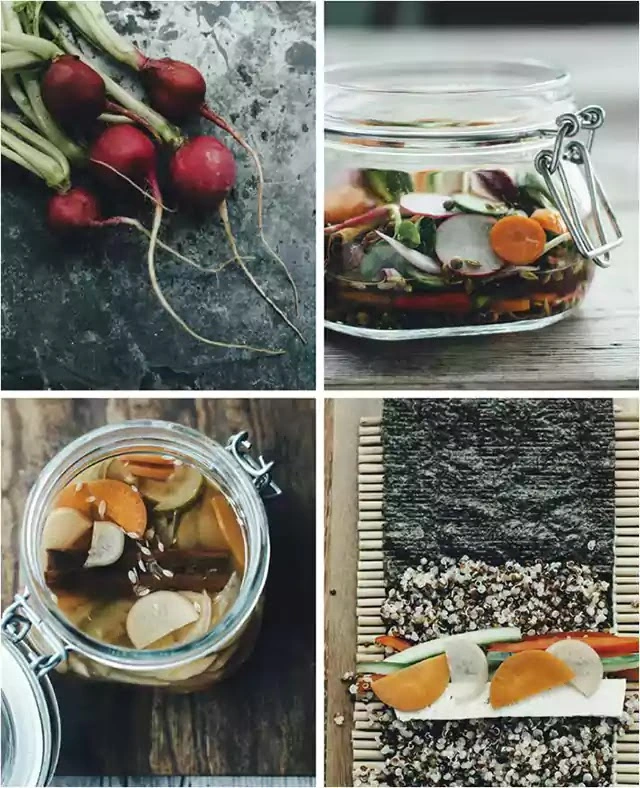
Nori omelette with miso mushroom broth
This recipe is a great way to start your day. I find if I have eggs for breakfast, I am not hungry or distracted by food until lunchtime. If you don’t have dashi, you could use a homemade stock. I use red miso in winter and lighter shiro miso in the hotter months as it is less salty.
- 8 free-range eggs
- 4 spring onions, sliced, plus extra to serve
- 3 tablespoons olive oil
- 2 nori sheets, torn, plus extra to serve
- 300 g mixed mushrooms (such as shiitake, enoki, Swiss brown, chestnut, oyster)
- 1 teaspoon red miso
- 250 ml (1 cup) hot dashi stock
Whisk together the eggs and spring onion.
Heat ½ tablespoon of the oil in a 20 cm non-stick frying pan over medium heat. Add a quarter of the eggs and top with a quarter of the torn nori. Cook until the edge starts to set, then lift the edge and tilt the pan so that any uncooked egg runs underneath. Cook until just set, then turn over and cook on the other side until set. Transfer to a plate and keep warm. Repeat to make four omelettes in total.
Heat the remaining oil in a large non-stick frying pan over high heat, add the mushrooms and cook for 5 minutes, until they are golden brown and any moisture has evaporated.
Blend the miso with the dashi, pour over the mushrooms, reduce the heat to low and cook, without boiling, for 5 minutes.
Place each omelette in a shallow bowl and pour over the miso mushroom broth. Top with the extra nori and spring onion.
Serves 4
In winter, I wrap warmed cooking salt in a tea towel and lay it over my kidneys; it warms me to the bones.
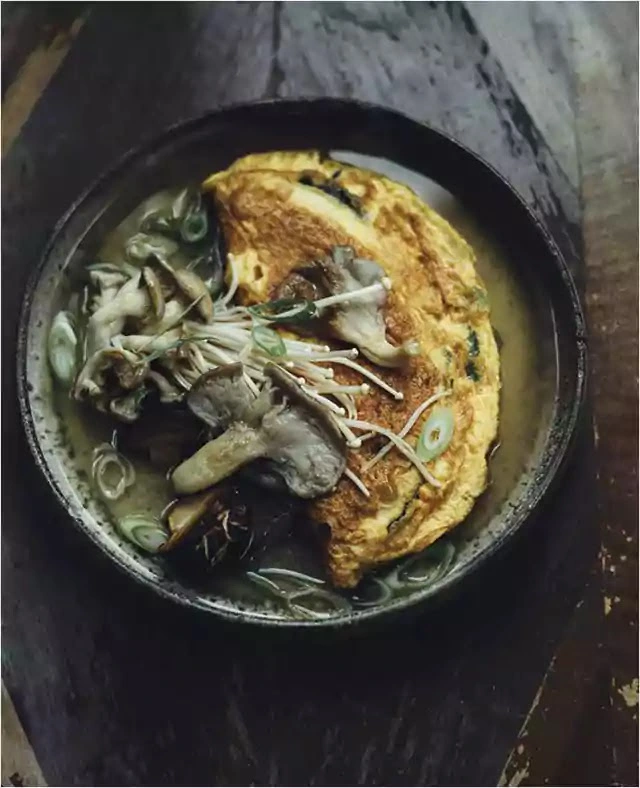
Nourishing buckwheat risotto
- 245 g (1¼ cups) buckwheat, rinsed
- 2 tablespoons olive oil
- 1 onion, chopped
- 2 celery stalks, chopped
- 1 carrot, chopped
- 1 red capsicum, chopped
- 1 teaspoon hot smoked paprika
- 400 g can chopped tomatoes
- finely grated zest of 1 orange
- 2 bay leaves
- 750 ml (3 cups) vegetable stock
- 150 g baby spinach leaves, finely shredded
- 100 g haloumi, grated
- 2 tablespoons pepitas
Toast the buckwheat in a large frying pan over medium heat for 10 minutes, until it smells toasted and nutty. Set aside.
Heat the oil in a large saucepan over medium heat, add the onion and cook, stirring occasionally, for 10 minutes, until golden. Stir in the celery, carrot and capsicum and cook for 5 minutes, until starting to soften. Sprinkle the paprika over the vegetables and cook, stirring, for 1 minute, until fragrant.
Add the buckwheat, tomatoes, orange zest, bay leaves and stock to the pan and bring to the boil. Reduce the heat to low and simmer for 40 minutes, until the buckwheat grains are tender. You may need to add some hot water if the buckwheat starts to dry out.
Just before serving, stir in the spinach and cook until wilted. Serve the risotto topped with the haloumi and sprinkled with the pepitas.
Serves 4
Steamed eggplant with black vinegar dressing
- 4 Japanese eggplants
- 2 garlic cloves, finely chopped
- 1 tablespoon finely shredded fresh ginger
- 1 long red chilli, seeded and thinly sliced
- ½ teaspoon sesame oil
- 3 tablespoons black vinegar
- 1 teaspoon coconut sugar
- Thai basil sprigs, to serve
- hot paprika, to serve
Cut the eggplants in half lengthways and sprinkle with salt. Set aside for 5 minutes. Rinse and pat dry with paper towel.
Place the eggplant in a shallow heatproof bowl and transfer to a bamboo steamer over a saucepan of simmering water. Cover and cook for 10 minutes, until the eggplant is soft. Drain off any excess liquid.
Whisk together the garlic, ginger, chilli, sesame oil, vinegar and sugar and pour over the eggplant. Top with the basil and paprika.
Serves 4
Tandoori cauliflower and tempeh
I have to be honest, I have struggled with tempeh in the past. I found the flavour overpowering when I cooked it in stir-fries or on the barbecue. I don’t know if it was because I was purchasing inferior quality supermarket tempeh or if I just had not found the right recipe for it. I now have found this amazing woman who makes and sells it at my local market, and it is truly delicious.
Because tempeh is a fermented food, it is considered a much healthier way of eating soya beans than tofu.
- ½ teaspoon sea salt
- 1 teaspoon ground coriander
- 1 teaspoon chilli powder
- 1 teaspoon sweet paprika
- 1 teaspoon turmeric
- 1 teaspoon garam masala
- 1 teaspoon ground cumin
- 3 cm piece of fresh ginger, peeled and grated
- 2 garlic cloves, crushed
- 3 tablespoons olive oil
- 3 tablespoons lemon juice
- 130 g (½ cup) Greek-style yoghurt
- 200 g cauliflower, broken into florets
- 1 red capsicum, chopped
- 200 g broccoli, broken into florets
- 375 g tempeh, cut into thick matchsticks
- Thai basil leaves, to serve
- 50 g toasted unsalted cashews, to serve
- steamed brown rice, to serve
Put the spices in a bowl, add the ginger, garlic, oil, lemon juice and yoghurt and mix to combine. Mix in the cauliflower, capsicum, broccoli and tempeh. Cover and marinate for a couple of hours or as long as time permits.
Preheat the oven to 200°C. Line a large baking tray with baking paper.
Spread the marinated tempeh and vegetables on the prepared tray and bake for 30 minutes, until the vegetables are soft. Sprinkle with the basil leaves and toasted cashews and serve with the brown rice.
Serves 4



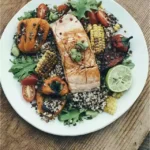

GIPHY App Key not set. Please check settings